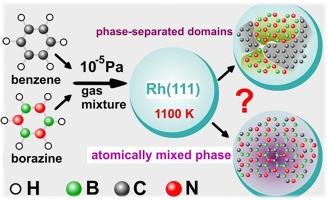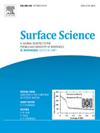利用苯-硼嗪混合物在 Rh(111) 上制备 B-C-N 纳米薄片
IF 1.8
4区 化学
Q3 CHEMISTRY, PHYSICAL
引用次数: 0
摘要
20 世纪 70 年代中期,当我们在塞格德的研究小组开始在超高真空(UHV)下对固体表面进行原子级研究时,已经过去了 15-20 年。在此之前,已经开发出了几种非常重要的方法,如超高真空技术、商用电子和光电子能谱技术等。对金属和半导体(氧化物)表面的特征及其吸附特性的研究已经非常广泛。无论如何,在过去的 40-50 年间,我们也见证了许多重大发现和令人振奋的新技术。仅考虑到与我们研究小组主要关注的异相催化相关的活动,就出现了新的突破性方法,如 HREELS、RAIRS、SPM、NAPXPS、EXAFS 和 NEXAFS。沿着这条道路,出现了新的实验和理论方法,如平面模型催化剂和反催化剂、原子级研究和理解表面扩散控制现象(颗粒生长和破坏、强金属-支撑相互作用(SMSI)、装饰、溢出)、活性位点的原子级识别、自组织纳米系统、表面合金和纳米模板。能够参与这项神奇的活动已有 50 多年,我感到非常高兴。在过去的二十年里,无论是在国际上还是在塞格德本地,表面科学都为诸如半金属石墨烯和绝缘体六方氮化硼等二维材料打开了广阔的世界。然而,由于相分离的主要趋势,C、B 和 N 混合层的形成被证明是一项艰巨的任务。在本研究中,我们报告了一种以苯/硼嗪混合物为前驱体在 Rh(111) 上制备蜂窝状 "BCN "材料的方法。结果表明,通过适当选择生长参数,可以避免形成大的、分离的石墨烯和 h-BN 岛。本文章由计算机程序翻译,如有差异,请以英文原文为准。

Fabrication of B-C-N nanosheets on Rh(111) from benzene – borazine mixtures
Atomic level studies of solid state surfaces performed in ultra-high vacuum (UHV) had already an energetic 15–20 years past when our research group in Szeged started working in this field in mid 1970s. Till then several very important methods had been developed, like UHV technology, commercially available electron and photoelectron spectroscopy techniques, etc. Characterization of metal and semiconductor (oxide) surfaces and their adsorption properties had already been widely studied. In any case, the last 40–50 years also witnessed great discoveries and exciting new techniques. Considering only the activity related to heterogeneous catalysis, the main focus of our research group, new breakthrough methods emerged like HREELS, RAIRS, SPM, NAPXPS, EXAFS, NEXAFS. Along this path, new experimental and theoretical approaches appeared like planar model catalysts and inverse catalysts, atomic level investigation and understanding of surface diffusion-controlled phenomena (particle growth and disruption, strong metal-support interaction (SMSI), decoration, spillover), atomic level identification of active sites, self-organized nano-systems, surface alloys and nanotemplates. It was great to participate in this magical activity for more than 50 years. Both internationally and locally in Szeged, in the last two decades, surface science has opened to the wide world of 2D materials like the semimetal graphene and the insulator hexagonal boron nitride. However, the formation of a mixed layer of C, B and N proved to be a difficult task due to the primary tendency for phase separation. In the present work, we report on a preparation method of honeycomb “BCN” materials on Rh(111) by using benzene/borazine mixtures as precursors. It was demonstrated that by a suitable choice of the growth parameters, the formation of large, separated graphene and h-BN islands can be avoided.
求助全文
通过发布文献求助,成功后即可免费获取论文全文。
去求助
来源期刊

Surface Science
化学-物理:凝聚态物理
CiteScore
3.30
自引率
5.30%
发文量
137
审稿时长
25 days
期刊介绍:
Surface Science is devoted to elucidating the fundamental aspects of chemistry and physics occurring at a wide range of surfaces and interfaces and to disseminating this knowledge fast. The journal welcomes a broad spectrum of topics, including but not limited to:
• model systems (e.g. in Ultra High Vacuum) under well-controlled reactive conditions
• nanoscale science and engineering, including manipulation of matter at the atomic/molecular scale and assembly phenomena
• reactivity of surfaces as related to various applied areas including heterogeneous catalysis, chemistry at electrified interfaces, and semiconductors functionalization
• phenomena at interfaces relevant to energy storage and conversion, and fuels production and utilization
• surface reactivity for environmental protection and pollution remediation
• interactions at surfaces of soft matter, including polymers and biomaterials.
Both experimental and theoretical work, including modeling, is within the scope of the journal. Work published in Surface Science reaches a wide readership, from chemistry and physics to biology and materials science and engineering, providing an excellent forum for cross-fertilization of ideas and broad dissemination of scientific discoveries.
 求助内容:
求助内容: 应助结果提醒方式:
应助结果提醒方式:


